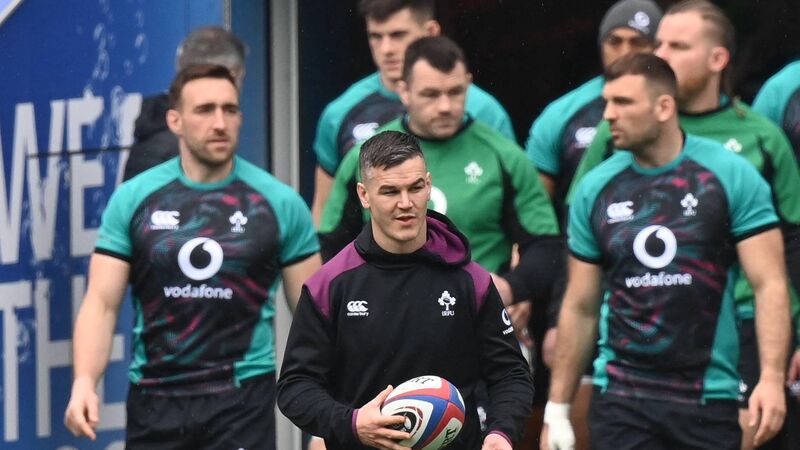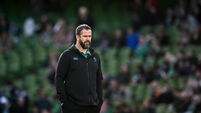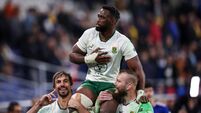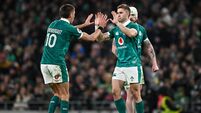Donal Lenihan: This Irish team is superior to England in too many sectors

Ireland's fly-half Johnny Sexton (c) arrives on the pitch for a training session of the Ireland's rugby team, at Twickenham Stadium, in London, on March 11, 2022 on the eve of the Six Nations international rugby union match between England and Ireland. (Photo by Glyn KIRK / AFP) (Photo by GLYN KIRK/AFP via Getty Images)
You may have heard the one by now about Bill Beaumont, leading out an English team in Twickenham and declaring to his opposite number Moss Keane “may the best team win”.
“Christ” said Moss “I hope not”.
The fact that the exchange never happened is irrelevant.
We all know by now the better team, in any sporting contest, doesn’t always take the spoils.
There’s no doubt in my mind who the better team is in Twickenham today but that doesn’t guarantee an Irish win.
This Irish team is superior to England in a number of factors, the most basic being personnel.
If a Lions test side was being picked today, Maro Itoje would be the only English certainty to start up front with Marcus Smith the only member of an England back division that doesn’t have a single player who started in Dublin last year to even come into the selection debate.
This English side appears a bit lost at the moment. They have very few dominant personalities. When you think of England now, you think more about the coach, Eddie Jones. They appear to have lost their way slightly.
Even Itoje, their standout forward who was central to England’s three successive wins over Ireland before that losing sequence was arrested by that dominant 32-18 win in Dublin in last season's championship, has struggled recently to rise above the general malaise up front.
Ireland have only lost once - to France - in their last 11 games played since developing a more high tempo, wide attacking game, predicated on keeping the ball alive in the tackle and utilizing two distinct lines of attack with a number of key forwards now comfortable acting as an attacking pivot.
The one big blow in advance of today’s game is the loss of both Andrew Porter and Ronan Kelleher in the front row.
While Dan Sheehan was excellent when introduced after only 25 minutes in the bristling cauldron of the Stade de France and equally impressive against Italy last time out, it is his impact off the bench that will be missed today.
His bench replacement Rob Herring is a competent setpiece operator but doesn’t have the skillset Sheehan carries in the last quarter. While Cian Healy and Dave Kilcoyne bring massive experience and presence to the matchday squad, Porter’s raw power, explosive carrying ability and aggressive cleanouts at the breakdown will be missed.
The England starting scrum is vulnerable with Ellis Genge and Kyle Sinckler, both key figures in broken play, suspect in their primary role at scrum time.
With Porter and Kelleher missing, Ireland may not be able to exploit that potential weakness to the same degree.
That said, this English pack doesn’t quite pack the bulk and power of old.
Ireland, with quality players in Jack Conan and Iain Henderson held in reserve, need to exploit that fact.
England have reached a crossroads in this championship. Having finished fifth in last season's Six Nations, defeat to Ireland today with the French next up in Paris would signal another disastrous campaign for Eddie Jones.
For the second successive tournament, Ireland represents a litmus test for Jones and his team. At the breakfast review after the defeat in Dublin last March, Jones made it absolutely clear to his players that a number of them would never play for England again. Five of that starting team, including the most high-profile casualties in the Vunipola brothers, have failed to appear since.
Since then Jones has fast-tracked a number of younger players in Freddie Steward, Marcus Smith, Harry Randall, Alex Dumbrandt and Max Malins into the starting side with mixed success. He craves the familiarity that Andy Farrell has at his disposal in having 11 Leinster players starting, with two more on the bench in today’s matchday squad. His starting side today is drawn from eight different Gallagher Premiership sides. He identifies that level of understanding as a key element in Ireland’s success.
Jones is now searching for a more unstructured game, with less pre-ordained pods of players filling pre-planned slots, which places a heavy reliance on a comparative rookie in out half Smith to run the show.
Having had to cope on so many occasions with seeking to undermine the key role his son Owen so often plays in England’s attacking structure, Farrell will enjoy setting in motion a plan to minimize Smith’s growing influence on England’s new attacking shape given the heavy reliance on him to make things happen in the absence of Farrell junior today.
Opposite Smith is a man 13 years his senior who has seen and done it all at this level. In a week when Johnny Sexton mapped out the closing chapter of a remarkable career, with next year’s World Cup in France set to sign off his remarkable legacy, Sexton will be very aware of the threat posed by his opposite number.
Once upon a time, Sexton was that brash young man in a hurry to conquer the rugby world. He will appreciate too that Smith is already ahead of where he was that age, and that he was called out as a replacement to the recent Lions tour ahead of him.
Jones has not only dramatically changed the personnel involved over the last 12 months but is clearly looking to alter the way his team plays. The key question today is whether he sticks to that plan or looks to adopt a more negative approach, based on battering Ireland physically.
His latest press comments when suggesting he would subject Ireland to a level of physicality they have never experienced before resembles a step back in time. Then again that approach has a long history of success.
So much of Ireland’s new attacking fluidity is based on the speed with which the ball is being recycled at the breakdown, now statistically recognized as the quickest in the tournament. With 69% of rucks being recycled in 2.89 seconds, despite committing only two forwards to 74% of those rucks in achieving that, opposition defences are being offered very little time to re-set, thus reducing their line speed and ability to stifle Ireland’s attacking options.
Ireland’s clinical ball presentation at the ruck, a remnant of the Joe Schmidt era, and something Paul O'Connell has worked on assiduously to improve, is a crucial element in the overall plan. England’s back row of Tom Curry, Courtney Lawes and Sam Simmons along with Itoje and Jamie George, Lions all last summer, will be tasked with breaking this crucial link in the high speed recycling machine O'Connell and Farrell have devised.
With the speed of pass Jamison Gibson-Park brings at the base of the ruck, Ireland’s attack has flourished against most opponents. The one setback came in Paris when the French forwards refused to let Ireland dictate the contact area. They managed to stop Ireland on the gain line and killed their momentum.
England’s three dominant wins over Ireland in 2019 and 2020 were based on achieving that same physical dominance. Those English sides were underpinned by a very productive setpiece coupled with the ability to disrupt opposition set-piece ball, by big powerful carriers in Mako and Billy Vunipola, George Kruis and Joe Marler, none of whom start today. In addition, their line speed in defence created massive problems for Ireland.
The issue for England at present is they don’t appear to have any distinctive style or any key points of difference that separate them from other teams. They continue to wait in forlorn hope for the return to arms of the injury-ravaged Manu Tuilagi, who has now missed an incredible 81 test matches through injury since first appearing on the scene in the warm up tests prior to the 2011 World Cup. All things being equal, Ireland should win today. After all, they are the better team!









